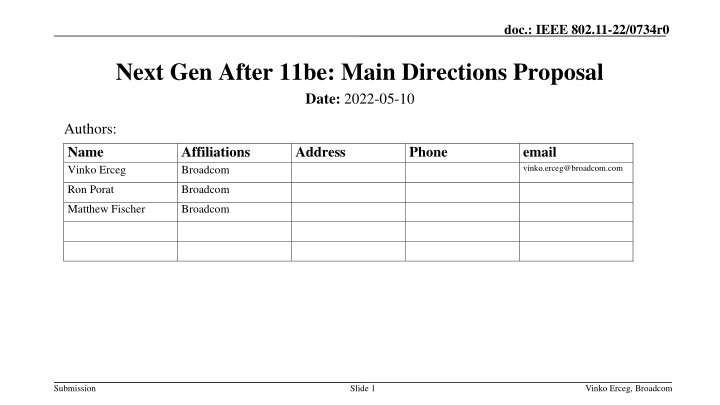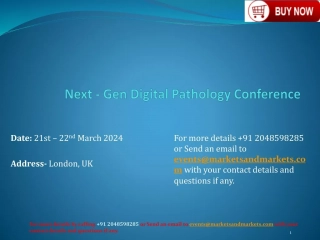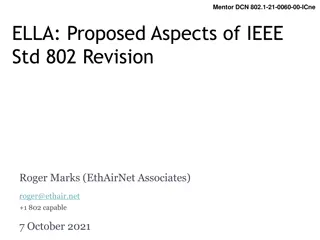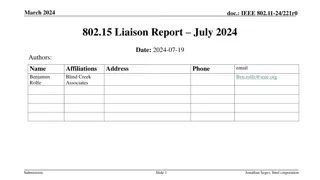Proposed Main Directions for Next-Gen IEEE 802.11 Standard
This proposal outlines a focused approach for utilizing spectrum below 7GHz, aiming for reliable communication with high data rates. It emphasizes spectral efficiency, throughput improvements, enhanced channel access, reliability, coverage, and reduced latency, targeting various use cases such as AR/VR, gaming, robotics, and backhaul applications. Additionally, suggestions for new features like bandwidth expansion in the 5GHz and 6GHz bands are presented for consideration in the upcoming standard evolution.
Download Presentation

Please find below an Image/Link to download the presentation.
The content on the website is provided AS IS for your information and personal use only. It may not be sold, licensed, or shared on other websites without obtaining consent from the author.If you encounter any issues during the download, it is possible that the publisher has removed the file from their server.
You are allowed to download the files provided on this website for personal or commercial use, subject to the condition that they are used lawfully. All files are the property of their respective owners.
The content on the website is provided AS IS for your information and personal use only. It may not be sold, licensed, or shared on other websites without obtaining consent from the author.
E N D
Presentation Transcript
doc.: IEEE 802.11-22/0734r0 Next Gen After 11be: Main Directions Proposal Date: 2022-05-10 Authors: Name Vinko Erceg Affiliations Broadcom Address Phone email vinko.erceg@broadcom.com Ron Porat Broadcom Matthew Fischer Broadcom Submission Slide 1 Vinko Erceg, Broadcom
doc.: IEEE 802.11-22/0734r0 Abstract Main Directions Proposal for the Next Generation PHY/MAC Task Group Submission Slide 2
doc.: IEEE 802.11-22/0734r0 High Level Approach and Potential Next Gen Targets We prefer a focused and unified approach to improve usage of the newly received 6GHz spectrum along with 5GHz and 2.4GHz spectrum In our view spectrum below 7GHz provides the best way to achieve reliable communication with high data rate, especially in NLOS conditions common in indoor/outdoor environments Higher spectral efficiency/throughput Approach 1Gbps throughput over target area House, apartment buildings, office, venues, .. Significantly more efficient channel access Results in better usage of wider bandwidths Higher reliability Better coverage Lower latency Submission Slide 3
doc.: IEEE 802.11-22/0734r0 Main Use Cases Envisioned AR/VR Video Distribution Fast data transfers Gaming Automation Automotive Robotics Medical Surgical Applications Backhaul Social Media Submission Slide 4
doc.: IEEE 802.11-22/0734r0 Features From 11be That May be Reconsidered for Next Gen Multi-AP Frequency/Time coordination Coordinated SR BF and nulling JT Secondary channel access protocol Important for wider BWs TB Punctured PPDU A-PPDU (aggregate OFDMA PPDU, 11be/next gen aggregation) Lower CSI feedback BA Modification Improved link adaptation Fast feedback Added MCS for denser grid Multi-layer Transmission Note: HARQ seems too complex for gains seen (improved link adaptation may be a better choice) Submission Slide 5
doc.: IEEE 802.11-22/0734r0 New Feature: BW Expansion in 5GHz Band 5895 MHz 5490 MHz 5735 MHz Expand to 240MHz BW in UNII2 Submission Slide 6
doc.: IEEE 802.11-22/0734r0 New Feature: BW Expansion in 6GHz Band 802.11be Channelization 320 MHz channelization is defined Partially overlapping 320 channels to maximize utility UNII5 80 160 UNII6 80 6,7 80 UNII7 80 160 7,8 80 UNII8 80 160 80 80 80 80 80 80 80 80 160 160 160 160 320-1 320-1 320-1 320-2 320-2 320-2 480-1 480-1 480-2 480-2 560 160 640 560 640 160 160 160 160 160 Expand to 480MHz channels e.g. 4 channels, two for 320-1 set and two for 320-2 set Expand to 640MHz channels Two non-overlapping 560MHz channels Two 640MHz channels with 160MHz overlap Submission Slide 7
doc.: IEEE 802.11-22/0734r0 New Features: Bandwidth Expansion Summary of Rates Wider bandwidths (along with STR and MU-MIMO option) 240 MHz in 5GHz band 480 MHz in 6GHz band 640 MHz in 6GHz band 5GHz (Gbps) 6GHz (Gbps) Total SU-MIMO (MLO STR) 5GH+6GHz (Gbps) Total MU-MIMO (3 users, x3) (MLO STR) 5GH+6GHz (Gbps) Nss (per user) 240MHz 320MHz 480MHz 640MHz 240MHz+ 320MHz 240MHz+ 480MHz 240MHz+ 640MHz Total Nss/ Total # AP antennas 240MHz+ 320MHz 240MHz+ 480MHz 240MHz+ 640MHz 2 4.4 5.8 8.7 11.6 6/8 30.6 39.3 48 10.2 13.1 16 3 6.5 8.7 13.1 17.4 9/12 45.6 58.8 71.7 15.2 19.6 23.9 4 8.8 11.6 17.4 23.2 12/16 61.2 78.6 96 20.4 26.2 32 Submission Slide 8
doc.: IEEE 802.11-22/0734r0 Secondary Channel Utilization Very important in order to utilize wider bandwidths Currently Wi-Fi greatly suffers because of artificial channel access rules applied for 20MHz channels 20+ years ago Wider BW transmission can be utilized only if primary channels are free Incredible waste of efficiency Should have been already addressed during 11ac standard development Allow transmissions on secondary channels when primary channels are occupied Crucial for 160MHz and larger bandwidths, even for 80MHz https://mentor.ieee.org/802.11/dcn/20/11-20-0363-03-00be-proposals-on-unused-bandwidth- utilizations.pptx Already specified by the ETSI harmonized standard for 5 GHz (EN 301 893) Expected to be copied into the ETSI rules for 6GHz Already supported by LAA and NR-U Submission Slide 9
doc.: IEEE 802.11-22/0734r0 Benefits Matrix of Potential Wi-Fi 8 Features Gain Peak Throughput System Throughput Latency Range/ Higher Reliability Higher Rate at Range Multi-AP multiplicative YES (for JT) YES YES YES YES Secondary channel access multiplicative YES YES YES Wider bandwidths multiplicative YES YES YES YES TB Punctured PPDU efficiency YES YES A-PPDU efficiency YES YES Multi-layer transmission additive YES YES YES Lower CSI feedback efficiency YES YES BA modification efficiency coexistence YES YES Enhanced long range improved performance YES YES Submission Slide 10
doc.: IEEE 802.11-22/0734r0 Next Gen: Possible Feature Set for Consideration - Summary Core: Subset of the following features: TB Punctured PPDU A-PPDU (aggregate OFDMA PPDU, 11be/next gen aggregation) Lower CSI feedback BA Modification Improved link adaptation Fast feedback Added MCS for denser grid Multi-layer Transmission Other: Enhanced long range TBD (SG/TG will for sure come up with quite a few other compelling ideas) Meaningful subset of Multi-AP features Secondary channel access Wider bandwidth Submission Slide 11























